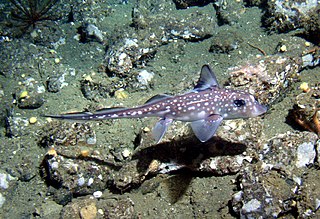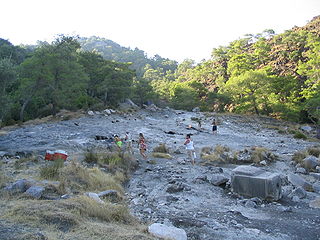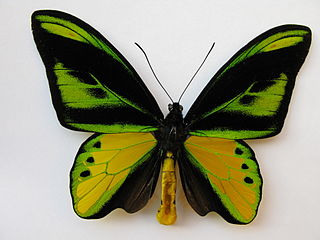Chimera, Chimaera, or Chimaira originally referred to:

According to Greek mythology, the Chimera, Chimaera, or Chimæra was a monstrous fire-breathing hybrid creature from Lycia, Asia Minor, composed of different animal parts. It is usually depicted as a lion, with the head of a goat protruding from its back, and a tail that might end with a snake's head. It was an offspring of Typhon and Echidna and a sibling of monsters like Cerberus and the Lernaean Hydra.

Chimaeras are cartilaginous fish in the order Chimaeriformes, known informally as ghost sharks, rat fish, spookfish, or rabbit fish; the last three names are not to be confused with rattails, Opisthoproctidae, or Siganidae, respectively.

Mount Chimaera was the name of a place in ancient Lycia, notable for constantly burning fires. It is thought to be the area called Yanartaş in Turkey, where methane and other gases emerge from the rock and burn. Some ancient sources considered it to be the origin of the myth of the monster called the Chimera, because of similarities described below.

House with Chimaeras or Horodetsky House is an Art Nouveau building located in the historic Lypky neighborhood of Kyiv, the capital of Ukraine. Situated across the street from the President of Ukraine's office at No. 10, Bankova Street, the building has been used as a presidential residence for official and diplomatic ceremonies since 2005. The street in front of the building is closed off to all automobile traffic, and is now a patrolled pedestrian zone due to its proximity to the Presidential Administration building.

Jyu-Oh-Sei is a Japanese manga series written and illustrated by Natsumi Itsuki. The manga was first serialized in Hakusensha's monthly shōjo manga magazine, LaLa in December 1993. Several chapters of the series were serialized in Hakusensha's other bi-monthly shōjo manga magazine, Melody. The chapters released were then collected into five tankōbon volumes and later re-released into three kanzenban volumes. It was licensed and released in English in North America by Tokyopop, with translations by Yuya Otake and English adaptation by Clint Bickham.
The narrownose chimaera is a longnose chimaera of the family Rhinochimaeridae, the longnose chimaeras, consisting of eight species belonging three genera. This species is found in temperate seas worldwide, at depths between 200 and 3,100 m. Its length is between 1.0 and 1.5 m, including a long, tapering snout and a long, filamentous tail.

The angular angelshark or Squantina guggenheim are sharks of the Squantina genus in the Squantinidae family. They originate in Brazil and Argentina, while living in marine, brackish and demersal environments at depth of approximately 4-360m. Their typical food sources consist of bony fish, crustaceans, and mollusks.

Ornithoptera chimaera, the chimaera birdwing, is a birdwing butterfly of the family Papilionidae. It is found in mountain areas of New Guinea, 1000 meters above sea level.
Mycobacterium avium complex is a group of mycobacteria comprising Mycobacterium intracellulare and Mycobacterium avium that are commonly grouped because they infect humans together; this group, in turn, is part of the group of nontuberculous mycobacteria. These bacteria cause Mycobacterium avium-intracellulare infections or Mycobacterium avium complex infections in humans. These bacteria are common and are found in fresh and salt water, in household dust and in soil. MAC bacteria usually cause infection in those who are immunocompromised or those with severe lung disease.

USS Chimaera (ARL-33) was one of 39 Achelous-class landing craft repair ships built for the United States Navy during World War II. Named for the Chimaera, she was the only U.S. Naval vessel to bear the name.
The paddlenose chimaera or paddlenose spookfish is a species of fish in the family Rhinochimaeridae found near China, Japan, Mozambique, South Africa, and Taiwan. Its natural habitat is open seas. It is threatened by habitat loss.
The broadnose chimaera, knifenose chimaera, spearnose chimaera, or straightnose rabbitfish is a species of fish in the family Rhinochimaeridae found near Canada, Colombia, France, Gambia, Iceland, Mauritania, Mexico, Namibia, Senegal, South Africa, Suriname, and the United States. Its natural habitat is open seas.

The Chimaeridae, or short-nosed chimaeras, are a family of cartilaginous fish.

The Rhinochimaeridae, commonly known as long-nosed chimaeras, are a family of cartilaginous fish. They are similar in form and habits to other chimaeras, but have an exceptionally long conical or paddle-shaped snout. The snout has numerous sensory nerve endings, and is used to find food such as small fish. The first dorsal fin includes a mildly venomous spine, used in defense.

Chimaera is the type genus of the cartilaginous fish family Chimaeridae.
Dermotherium is a genus of fossil mammals closely related to the living colugos, a small group of gliding mammals from Southeast Asia. Two species are recognized: D. major from the Late Eocene of Thailand, based on a single fragment of the lower jaw, and D. chimaera from the Late Oligocene of Thailand, known from three fragments of the lower jaw and two isolated upper molars. In addition, a single isolated upper molar from the Early Oligocene of Pakistan has been tentatively assigned to D. chimaera. All sites where fossils of Dermotherium have been found were probably forested environments and the fossil species were probably forest dwellers like living colugos, but whether they had the gliding adaptations of the living species is unknown.

Rhinochimaera pacifica, commonly known as the Pacific spookfish, knifenose chimaera, narrownose chimaera, Pacific long-nosed chimaera, or Pinocchiofish, is a species of chimaera in the family Rhinochimaeridae. It lives in various parts of the Pacific Ocean and can be characterized by its long snout.












